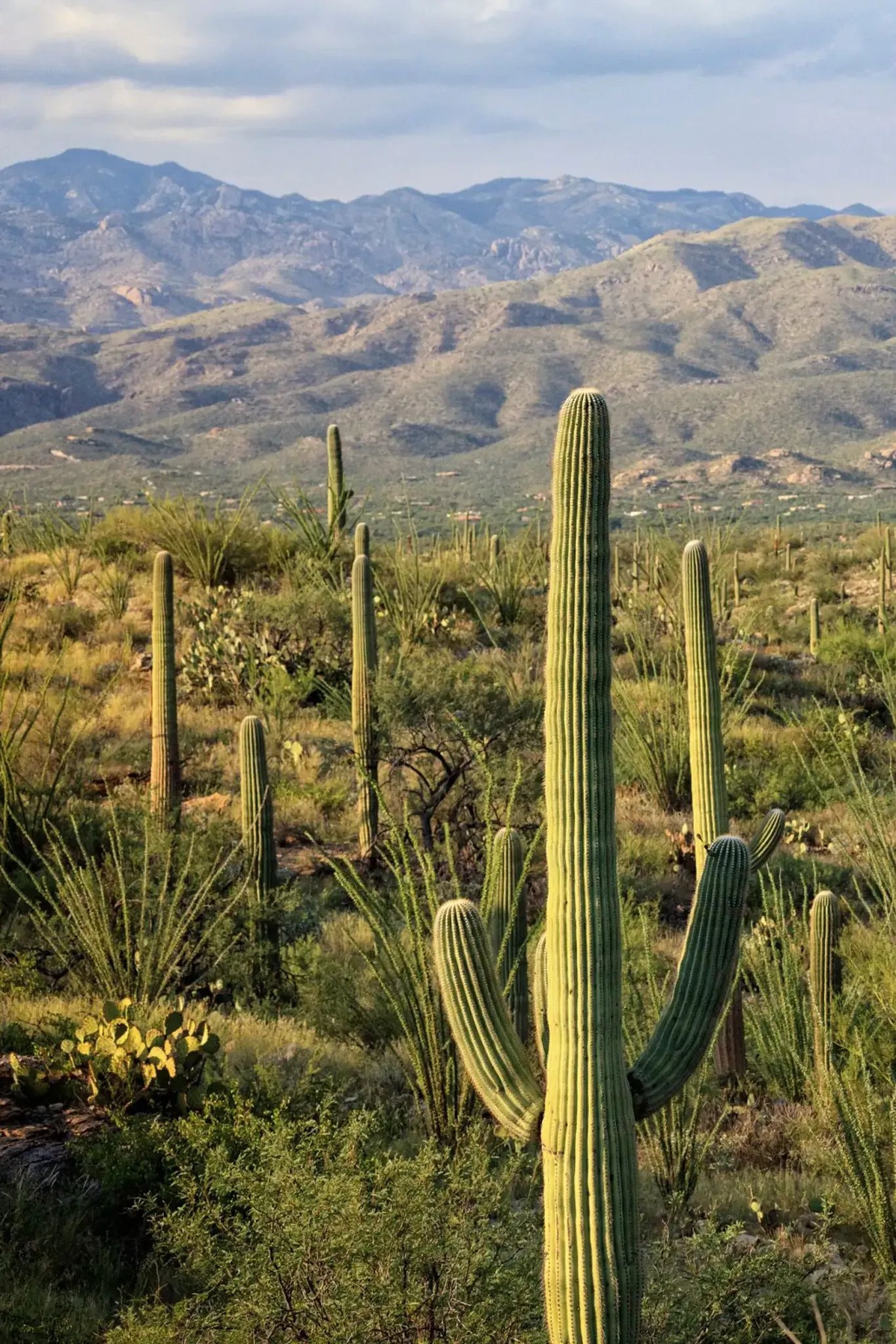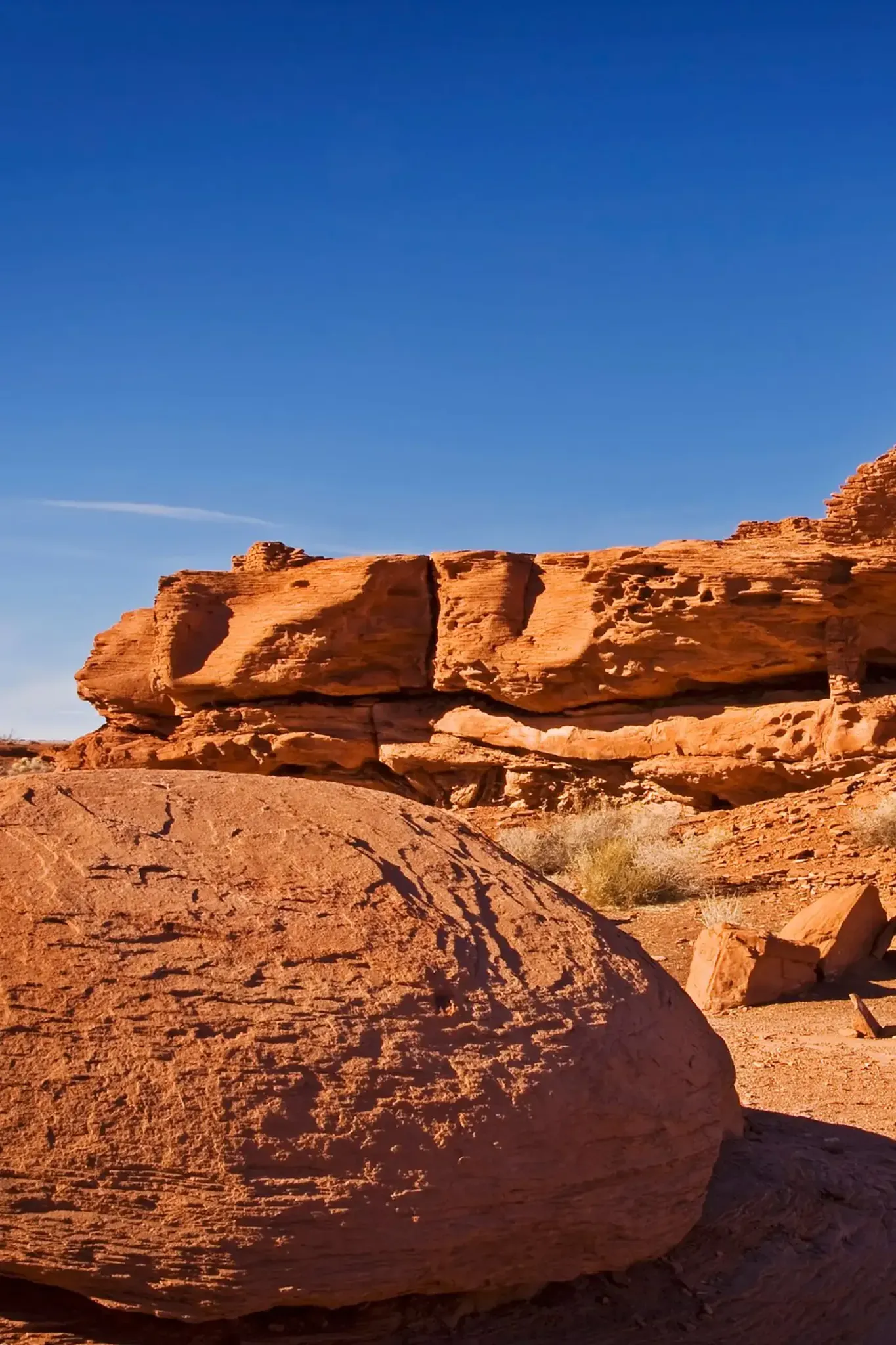Arizona National Parks reveal the rugged beauty of desert landscapes that combine ancient volcanoes and petrified wood with adobe architecture and innovative technologies from local ancestors.
 |
| National Parks in Arizona |
The United States National Park Service operates or owns 22 different national parks in Arizona, including monuments, historic trails, and sites, attracting over 13 million visitors each year. This article describes the most relevant parks and their cultural, ecological and geological significance.
Casa Grande Ruins National Monument
The ruins of Casa Grande are located in the Sonoran Desert in south-central Arizona, near Coolidge. The ruins represent the farming community of the Hohokam people (the ancient Sonoran Desert), a village built by early farmers from a Mesoamerican-influenced culture that flourished between AD 300 and 1450. The "Great House" after which the ruins are named is a late addition to the village, a four-story, 11-room building dating from around 1350 AD, one of the largest prehistoric structures ever built in North America. It was built from Kalishe, a natural combination of clay, sand and calcium carbonate, which was turned into mud and then used as a building material - when dry, it is as hard as concrete.The building could be a residential building, a temple or an astronomical observatory - no one knows exactly what its purpose is.
 |
| Casa Grande Ruins National Monument |
Long before the Great House was built, life along rivers in the desert became increasingly difficult to maintain as the population increased and people began building irrigation canals around AD 400-500. There are hundreds of miles of prehistoric irrigation canals around the Gila River, as well as the Salt River in Phoenix and the Santa Cruz River in Tucson, that allowed humans to grow corn, beans, pumpkin, cotton, and tobacco outside the valley.
Grand Canyon National Park
The Grand Canyon, located in north-central Arizona, is one of the most famous natural resources in the United States, a huge hole in the ground that runs 277 river miles along the Colorado River and is 18 miles wide and a mile deep. The geology presented at the base is igneous and metamorphic rocks laid down nearly two billion years ago, with stacked layers of sedimentary rocks on top of them. About 5-6 million years ago, the Colorado River began to carve the river valley and form a canyon. The population of the canyon and its surroundings began about 10,000 years ago or more, as evidenced by dwellings, garden plots, storage facilities and artifacts.Today, the ruins are important to the Havasupai, Hopi, Hualapai, Navajo, Payute, White Mountain Apache, Tusayan, Yavapai, and Zuni groups in the US Southwest and Mexico Northwest.
 |
| Grand Canyon National Park |
Although today millions of people visit the Grand Canyon every year, its first European explorers in the mid-19th century designated the canyon as the “great unknown,” an empty spot on the maps of the time. The first expedition, funded by the federal government, was conducted in 1857-1858 under the leadership of Senior Lieutenant Joseph Christmas Ives of the United States Army Surveyors of Engineers. He began sailing the Colorado River on a 50-foot stern-wheel steamer that crashed even before he entered the canyon. Fearless, he continued upriver by boat and then on foot to what is now a Hualapai Indian reservation.He said that the region was "completely useless", but "lonely and majestic", doomed to forever remain unnoticed and untouched.
Montezuma Castle National Monument
The Montezuma Castle National Monument, located near Camp Verde in central Arizona, is one of the very first national monuments in the United States, declared by President Theodore Roosevelt in 1906. The site preserves archaeological elements of the Southern Sinagua culture between 1100 and 1425 AD. These elements include rock dwellings (such as the Castle), pueblo ruins, and pits. The park also features the well of Montezuma, a collapsed limestone sinkhole from which an irrigation ditch was first built about 1000 years ago. The well of Montezuma contains organisms that are not found anywhere else in the world, which evolved in response to the unique mineralization of the water.
 |
| Montezuma Castle National Monument |
The monument is erected in the Sonoran Desert and therefore includes almost 400 plant species, such as mesquite, cat's claw and salt bush, adapted to life in arid environment. The park is laced with micro-habitats along river corridors with plants such as monkey and columbine, sycamore and poplar. Two hundred bird species inhabit the park for some part of the year, including the red-headed hummingbirds that pass through the park every year on their way from Alaska to Mexico.
Navajo National Monument
In the northeastern corner of the state, near Black Mesa, is the Navajo National Monument, created in 1909 to protect the remains of three large pueblos built between 1250-1300 AD, named Kit Seal, Betatakin, and the House of Inscriptions. Built in large natural niches in the rock, the houses were the homes of the ancestors of the Pueblo, who cultivated the terraces of the canyon creeks.
 |
| Navajo National Monument |
Apart from the large villages of pueblo, archaeological evidence supports human use of this region over the past several thousand years. First, hunter-gatherers lived in these canyons, then about 2000 years ago the people of basket-makers, and then the people of the ancestral pueblo, who hunted game and raised corn, beans and pumpkin. Modern tribes descended from the inhabitants include the Hopi, Navajo, San Juan southern payute and Zuni, and the park is surrounded by the Navajo people who have lived here for hundreds of years.
Organ Pipe Cactus National Monument
Located near Aho, on the border between Arizona and the state of Sonora in Mexico, the Cactus Organ National Monument is an international biosphere reserve established in 1976 to study and preserve the extraordinary collection of plants and animals found in the Sonoran Desert. Thirty-one species of cactus can be found here, ranging from the giant saguaro to the miniature needle bed, which are well developed for living in arid environments.
 |
| Organ Pipe Cactus National Monument |
Cacti bloom all year round in yellow, red, white and pink; In the spring, golden Mexican poppies, blue lupine and pink owl clover are added here. Organ pipe cacti live for over 150 years and only release their creamy white flowers at night after 35 years. The animals in the park include the Sonoran pronghorn antelope, bighorn sheep, mountain lion and bats. The park is home to about 270 bird species, but only 36 of them are permanent inhabitants, including Costa's hummingbirds, cactus wrens, crooked-billed thrashers and Gila's woodpeckers.
Petrified Forest National Park
The Petrified Forest National Park in east-central Arizona has two geologic formations: the Late Triassic Chinle Formation and the Mio-Pliocene Bidahochi Formation. The petrified logs found throughout the park are a coniferous species called Araucarioxylon arizonicum, a petrified Late Triassic pine that grew about 225 million years ago. The colored striped badlands of the Painted Desert date back to the same period and are composed of bentonite, a product of altered volcanic ash. The meshes and hills in the park are another detail created by erosion.
 |
| Petrified Forest National Park |
About 200,000 years ago, an ancient flood moved coniferous logs into the ancient river system, along with a huge amount of sediment and debris. The logs were buried so deep that oxygen was cut off and the decomposition process slowed down for centuries. Minerals, including iron, carbon, manganese and silica, dissolved from the volcanic ash, were absorbed by the cellular structure of the wood, replacing organic material as it slowly decays. The result is a petrified wood made up of nearly hard quartz - clear quartz, purple amethyst, yellow citrine, and smoky quartz. Each piece looks like a giant rainbow-colored crystal, often sparkling in the sun, as if covered in sparkles.
Saguaro National Park
Saguaro National Park, near Tucson, Arizona, is home to the largest cactus in the country and the universal symbol of the American West: the giant saguaro. The variety of heights in the park allows you to create a microclimate in which a wide variety of animal species live. There are 25 different types of cacti in the park alone, including a fishhook barrel, antler, pink-flowered hedgehog, and prickly pear.
 |
| Saguaro National Park |
The majestic saguaro cacti are the stars of the park, huge accordion-shaped trees tower overhead. The folds allow the cactus pulp to absorb and store water, swelling and expanding after heavy rain, and tapering as water is used during long dry periods. Saguaro cacti are home to a wide variety of animals. The gilded shimmery and Gila woodpecker dig the nest cavities inside the fleshy flesh, and after the woodpecker leaves the nest, elven owls, purple martins, finches and sparrows can enter it.
Sunset Crater Volcano National Monument
Near Flagstaff in north-central Arizona is the Sunset Crater Volcano National Monument, which houses the youngest, least eroded cinder cone of the 600 cones of the San Francisco volcanic field, a reminder of the last volcanic eruption on the Colorado Plateau. Hundreds of volcanic formations in the landscape were created by a series of eruptions that occurred around AD 1085 and were attested by the Indian tribes living here.
 |
| Sunset Crater Volcano National Monument |
Most of the park is covered with lava flows or deep volcanic ash deposits, broken by small islands of pine and aspen trees, desert bushes and other signs of the park's return to life. Plants such as Penstemon clutei ( dusk crater penstemon ) and Phacelia serrata (phacelia saw) are short-lived wildflowers found only on cinder deposits within the San Francisco volcanic field. They provide a unique opportunity to see and study the dynamics of eruption, change and recovery in an arid environment.
Tuzigut National Monument
The Tuzigut National Monument, located near Clarkdale in central Arizona, is an ancient pueblo village built by a culture known as the synagua. Tuzigoot pueblo (the Apache word for “crooked water”) has 110 rooms in a tenement house with second and third floors, and these have been occupied since the first buildings were built around 1000 AD. until about 1400, when Sinagua left the area. Sinagua were farmers who traded with people hundreds of miles away.
 |
| Tuzigut National Monument |
Although the climate is arid, with rainfall of less than 12 inches per year, the region is attractive for settlements due to the several perennial streams that flow from the upper bodies of water into the Verde Valley below. The park offers stunning views of lush coastal greenery and the Tavashi Swamp, surrounded by dry hills dotted with junipers, leading to a wide variety of plants and animals.
Wupatki National Monument
Wupatki National Monument, located near the Painted Desert and Flagstaff, includes the remains of what 800 years ago was the tallest, largest, and arguably the richest and most influential of all pueblos in the Four Corners region. The ancient Puebloans built their cities, raised families, engaged in agriculture, and prospered. In the surrounding area, there are juniper forests, meadows, and desolate bush communities with sweeping views of rolling hills, rolling hills, and volcanic hills.
 |
| Wupatki National Monument |
Much of Wupatka's geology is composed of Permian and Early-Middle Triassic sedimentary rocks dating back 200,000 million years ago and older. It is also home to "holes" where the ground breathes in and out gusts of wind depending on the current temperature and humidity.
